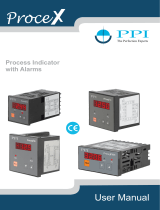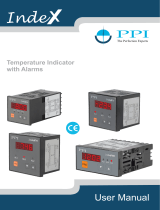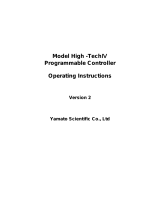Page is loading ...

170.IU0.MKP.CX0
2120 Programmer - Controller
2121 Programmer - Controller with heater break down alarm
2128 High performance controller
2129 High performance controller with heater break down alarm
Issue date r USER'S MANUAL
March 2001 0037-75424
XkP-0-1C1.P65 12/18/01, 4:21 PM1

XkP-0-1C1.P65 12/18/01, 4:21 PM2

INDEX
MOUNTING REQUIREMENTS .............................................. 1
OUTLINE AND CUT OUT DIMENSIONS ............................... 2
CONNECTION DIAGRAMS .................................................... 4
PRELIMINARY HARDWARE SETTINGS ............................. 19
SECURITY CODE SETTING MODE .................................... 23
RUN TIME AND CONFIGURATION MODES ....................... 26
GENERAL NOTE ABOUT GRAPHIC SYMBOLS
USED FOR MNEMONIC CODE VISUALIZATION. ....... 26
KEYBOARD DESCRIPTION ......................................... 27
CONFIGURATION MODE .................................................... 28
MONITOR MODE .......................................................... 29
MODIFY MODE ............................................................. 30
RUN TIME MODE ................................................................. 68
PRELIMINARY .............................................................. 68
CONTROL PARAMETERS ............................................ 69
CONTROL PARAMETERS PROTECTION .................... 69
CONTROL PARAMETERS MODIFICATION. ................ 79
PROGRAMMER MODE ...................................................... 101
BARGRAPH DESCRIPTION ....................................... 104
INDICATORS ............................................................... 105
DISPLAY FUNCTION DURING
PROGRAMMER MODE .............................................. 106
OUTPUT POWER OFF FUNCTION ............................ 109
CLOCK CALENDAR .................................................... 110
OUT FAILURE DETECTION FUNCTION (OFD) ......... 111
SERIAL LINK ............................................................... 111
LAMP TEST ................................................................. 112
MANUAL MODE .......................................................... 112
DIRECT ACCESS TO THE SET POINT ...................... 113
GENERAL NOTES ABOUT PROGRAM EDITING ...... 114
EDIT MODE ................................................................. 114
SIMPLE PROGRAM MANAGEMENT ......................... 122
LINKED PROGRAM MANAGEMENT .......................... 125
HOW TO CHECK A PROGRAM .................................. 126
HOW TO RUN A PROGRAM (SIMPLE OR LINKED) .. 127
ACTIONS AVAILABLE DURING RUNNING MODE .... 128
CONTOLLER MODE .......................................................... 131
DISPLAY FUNCTION DURING
CONTROLLER MODE ................................................ 132
INDICATORS FUNCTION DURING
CONTROLLER MODE ................................................ 134
DIRECT ACCESS TO THE SET POINT ...................... 134
SMART FUNCTION ..................................................... 135
OUTPUT POWER OFF FUNCTION ............................ 136
ERROR MESSAGES .......................................................... 137
GENERAL INFORMATIONS ............................................... 142
MAINTENANCE .................................................................. 151
DEFAULT PARAMETERS .................................................... A.1
CODING ............................................................................. A.15
XkP-0-1C1.P65 12/18/01, 4:21 PM3

Model identification
Model
2120 1/4 DIN Programmer - Controller with up to 200 segments in up to 99 programs
2121 1/4 DIN Programmer - Controller with up to 200 segments in up to 99 programs and with heater break down alarm
2128 1/8 DIN Programmer - Controller with up to 200 segments in up to 99 programs
2129 1/8 DIN Programmer - Controller with up to 200 segments in up to 99 programs and with heater break down alarm
Code Output 1 and 2 - control, alarm or event assignable
11 Relay / Relay
44 Triac / Triac
61 SSR Drive / Relay
66 SSR Drive /SSR Drive
Code Output 3 and 4 - control, alarm or event assignable
1 Relay / Relay
2 Relay / Relay interlockable by jumper
Code Analog Output 5 and 6 - control or retransmit assignable
5 Two mA outputs
7 One mA output
Code Options
0 None
1 Auxiliary power supply
2 RS-485 + Auxiliary power supply
4 RS-485 + Auxiliary power supply + clock
5 Auxiliary power supply + clock
6 RS-485 + Aux PWS+ 4 logic inputs + 5 digital outputs
7 RS-485 + Aux PWS+ 8 logic inputs + 10 digital outputs
8 RS-485 + Aux PWS+ 4 logic inputs + 5 digital outputs + clock
9 RS-485 + Aux PWS+ 8 logic inputs + 10 digital outputs + clock
Code Instrument Power
3 100 - 240 Vac
5 24 Vac/dc
2120 11 1 5 4 3 Typical Model Number
XkP-0-1C1.P65 12/18/01, 4:21 PM4

1
MOUNTING REQUIREMENTS
This instrument is intended for permanent installation,
for indoor use only, in an electrical panel which
encloses the rear housing, exposed terminals and
wiring on the back.
Select a location, for instrument mounting, where
minimum vibrations are present and the ambient
temperature is within 0 and 50 °C (32 and 122 °F).
The instrument can be mounted on a panel up to 15
mm thick with a cutout of 92 x 45 mm (2128 - 2129) or
92 x 92 mm (2120 - 2121).
For outline and cutout dimensions refer to Fig. 2.
The surface texture of the panel must be better
than 6,3 mm.
The instrument is shipped with rubber panel gasket.
To assure the IP65 and NEMA 4 protection, insert the
panel gasket between the instrument and the panel as
shown in fig. 1.
While holding the instrument against the panel
proceed as follows:
1) insert the gasket in the instrument case;
2) insert the instrument in the panel cutout;
3) pushing the instrument against the panel;
4) insert the mounting brackets as shown in fig.1;
Fig. 1
Gasket
bracket
bracket
Panel
Screw
Panel
Screw
brackets
Gasket
Screws
5) with a screwdriver, turn the screws with a torque between 0.3
and 0.4 Nm.
XKP-1-C1.p65 12/18/01, 4:22 PM1

2
OUTLINE AND CUT OUT
DIMENSIONS
Fig. 2.A OUTLINE AND CUT-OUT DIMENSIONS FOR 2128 - 2129 MODELS
XKP-1-C1.p65 12/18/01, 4:22 PM2

3
Fig. 2.B OUTLINE AND CUT-OUT DIMENSIONS FOR 2120 - 2121 MODELS
XKP-1-C1.p65 12/18/01, 4:22 PM3

4
Connections are to be made with the instrument
housing installed in its proper location.
A) MEASURING INPUTS
NOTE: Any external component (like zener barriers
etc.) connected between sensor and input terminals
may cause errors in measurement due to
excessive and/or not balanced line resistance or
possible leakage currents.
CONNECTION DIAGRAMS
Fig. 3 REAR TERMINAL BLOCK
XKP-1-C1.p65 12/18/01, 4:22 PM4

5
A.1) TC INPUT
Fig. 4 THERMOCOUPLE INPUT WIRING
NOTES:
1) Don’t run input wires together with power cables.
2) For TC wiring use proper compensating cable preferable
shielded.
3) When a shielded cable is used, it should be connected at
one point only.
3
+
_
Shield
1
3
+
_
Shield
1
4
RTD
1
3 4
RTD
1
3
A.2) RTD INPUT
Fig. 5 RTD INPUT WIRING
NOTES:
1) Don’t run input wires together with power cables.
2) Pay attention to the line resistance; a high line resistance may
cause measurement errors.
3) When shielded cable is used, it should be grounded at one
side only to avoid ground loop currents.
4) The resistance of the 3 wires must be the same.
XKP-1-C1.p65 12/18/01, 4:22 PM5

6
Shield
+
_
TX
3
1
11
7
A.3) LINEAR INPUT
Fig. 6 mA, mV AND V INPUTS WIRING
NOTES:
1) Don’t run input wires together with power cables.
2) Pay attention to the line resistance; a high line resistance may
cause measurement errors.
3) When shielded cable is used, it should be grounded at one
side only to avoid ground loop currents.
4) The input impedance is equal to:
< 5 W for 20 mA input
> 1 MW for 60 mV input
> 200 kW for 5 V input
> 400 kW for 10 V input
A.4) 2, 3 AND 4-WIRE TRANSMITTER INPUT
Fig. 7.A INPUTS WIRING FOR 2-WIRE TRANSMITTER
Shield
_
+
mA,
mV
or
V
3
1
+
_
G
mA
mV
or
V
1
3
XKP-1-C1.p65 12/18/01, 4:22 PM6

7
Fig. 7.B INPUTS WIRING FOR 3-WIRE TRANSMITTER
Shield
3
1
11
7
PWR
+
Out
TX
GND
Fig. 7.C INPUTS WIRING FOR 4-WIRE TRANSMITTER
NOTES:
1) Don’t run input wires together with power cables.
2) Pay attention to the line resistance; a high line resistance may
cause measurement errors.
3) When shielded cable is used, it should be grounded at one
side only to avoid ground loop currents.
4) The input impedance is lower than 5 W (20 mA input)
Shield
3
1
11
7
PWR
+
Out
+
TX
PWR
_
Out
_
XKP-1-C1.p65 12/18/01, 4:22 PM7

8
B) AUXILIARY INPUT
Fig. 8 AUXILIARY INPUT WIRING
NOTES:
1) This input is not isolated from measuring input. A double or
reinforced insulation between instrument output and power
supply must be assured by the external instrument.
2) Don’t run input wires together with power cables.
3) Pay attention to the line resistance; a high line resistance may
cause measurement errors.
8
9
10
11
DIG. 1
DIG. 2
DIG. 3
Shield
_
+
mA
or
V
6
5
+
_
G
mA
or
V
5
6
4) When shielded cable is used, it should be grounded at one
side only to avoid ground loop currents.
5) The input impedance is equal to:
< 5 W for 20 mA input
> 200 kW for 5 V input
> 400 kW for 10 V input
C) LOGIC INPUTS
Fig. 9.A - LOGIC INPUTS DIG 1, 2, 3 WIRING
XKP-1-C1.p65 12/18/01, 4:22 PM8

9
Fig. 9.B - LOGIC INPUTS IN 1, 2, 3 and 4 WIRING
58
59
IN 2
IN 3
56
57
IN 1
60
IN 4
Fig. 9.C - LOGIC INPUTS IN 5, 6, 7 and 8 WIRING
NOTES:
1) Do not run logic input wiring together with power cables.
2) Use an external dry contact capable of switching 0.5 mA,
5 V DC.
3) The instrument needs 110 ms to recognize a contact status
variation.
4) The logic inputs are NOT isolated by the measuring input.
A double or reinforced insulation between instrument input
and power line must be assured by the external element.
58
59
IN 6
IN 7
56
57
IN 5
60
IN 8
XKP-1-C1.p65 12/18/01, 4:22 PM9

10
3) The minimum active period to perform this measurement is
equal to 120 ms.
4) The input impedance is equal to 20 W.
14
15
Load
Current
transformer
D) CURRENT TRANSFORMER INPUT
Fig. 10 CURRENT TRANSFORMER INPUT WIRING
This input allows you to measure and display the current running
in the load, driven by a time proportional control output, during
the ON and OFF periods of the output cycle time. By this feature
it is also available the "Output failure detection" function (see
page 110).
NOTES:
1) This input is not isolated from measuring input.
2) Do not run current transformer input wiring together with AC
power cables.
XKP-1-C1.p65 12/18/01, 4:22 PM10

11
E.1) RELAY OUTPUTS
Fig. 11.A RELAY OUTPUTS 1,2,3 and 4 WIRING
OUT 1
23
NC
24
C
25
NO
OUT 2
27
C
NO
28
OUT 3
29
NO - OUT 3
OUT 4
30
C - OUT 3/4
31
NO - OUT 4
26
NC
The outputs from OUT 1 to OUT 4 are equipped with relays
having contact rating equal to 3A/250V AC on resistive load.
WARNING: When OUT 3 and 4 are used as independent relay
outputs the addition of the two currents must not exceed 3 A.
Fig. 11.B RELAY OUTPUTS 10 to 14 WIRING
OUT 10
61
NO OUT 10
62
NO OUT 11
NO OUT 12
63
64
NO OUT 13
65
NO OUT 14
66
COMMON
OUT 11
OUT 12
OUT 13
OUT 14
COMMON
XKP-1-C1.p65 12/18/01, 4:22 PM11

12
Fig. 11.C RELAY OUTPUTS 15 to 19 WIRING
The outputs from OUT 10 to 19 are equipped with relays having
contact rating equal to 0.5A/250V AC on resistive load.
GENERAL NOTES ABOUT RELAY OUTPUT WIRING
1) To avoid electrical shock, connect power line at the end of
the wiring procedure.
2) For power connections use No 16 AWG or larger wires rated for
at last 75 °C.
3) Use copper conductors only.
4) Don’t run input wires together with power cables.
For all relay outputs, the number of operations is 1 x 10
5
at
specified rating.
All relay contacts are protected by varistor against inductive load
with inductive component up to 0.5 A.
The following recommendations avoid serious problems which
may occur, when using relay output for driving inductive loads.
INDUCTIVE LOADS
High voltage transients may occur switching inductive loads.
Through the internal contacts these transients may introduce
disturbances which can affect the performance of the instru-
ment.
For all the outputs, the internal protection (varistor) assures a
correct protection up to 0.5 A of inductive component.
OUT 15
50
NO OUT 15
51
NO OUT 16
NO OUT 17
52
53
NO OUT 18
54
NO OUT 19
55
COMMON
OUT 16
OUT 17
OUT 18
OUT 19
COMMON
XKP-1-C1.p65 12/18/01, 4:22 PM12

13
The same problem may occur when a switch is used in series
with the internal contacts as shown in Fig. 12.
Fig. 12 EXTERNAL SWITCH IN SERIES WITH THE INTER-
NAL CONTACT
In this case it is recommended to install an additional RC
network across the external contact as shown in Fig. 12
The value of capacitor (C) and resistor (R) are shown in the
following table.
Anyway the cable involved in relay output wiring must be as far
away as possible from input or communication cables.
E.2) VOLTAGE OUTPUTS FOR SSR DRIVE
Fig. 13 SSR DRIVE OUTPUT WIRING
Logic level 0: Vout < 0.5 V DC.
Logic level 1:
14 V
+ 20 % @ 20 mA
24 V
+ 20 % @ 1 mA.
Maximum current = 20 mA.
LOAD
(mA)
<40 mA
<150 mA
<0.5 A
C
(mF)
0.047
0.1
0.33
R
(W)
100
22
47
P.
(W)
1/2
2
2
OPERATING
VOLTAGE
260 V AC
260 V AC
260 V AC
R
C
LOAD
LINE
+
_
_
+
24
25
OUT 1
SOLID STATE
RELAY
+
_
_
+
27
28
OUT 2
SOLID STATE
RELAY
XKP-1-C1.p65 12/18/01, 4:22 PM13

14
Rated current: from 50 mA to 1 A.
Rated voltage: from 24 V
RMS
to 240 V
RMS
-10 % +15 % (50/
60Hz)
Load type: resistive load only
NOTES 1) To avoid electrical shock, connect power line at
the end of the wiring procedure.
2) For power connections use No 16 AWG or larger
wires rated for at last 75 °C.
3) Use copper conductors only.
4) Don’t run input wires together with power cables.
5) This output is not fuse protected. Please, provide it
externally using a fuse with a I
2
t equal to128.
E.4) SERVOMOTOR OUTPUT
23
Load
24
Line
26
Load
27
Line
OUT 1
OUT 2
NOTE: This output is not isolated.
A double or reinforced insulation between instrument output and
power supply must be assured by the external solid state relay.
E.3) TRIAC OUTPUTS
Fig. 14 TRIAC OUTPUT WIRING
Switching mode: isolated zero crossing type.
XKP-1-C1.p65 12/18/01, 4:22 PM14

15
"Preliminary hardware setting" paragraph "Out 3 and 4
selection").
NOTES:
1) Before connecting the instrument to the power line, make sure
that line voltage and the load current are in accordance with the
contact rating (3A/250V AC on resistive load).
2) To avoid electric shock, connect power line at the end of the
wiring procedure.
3) For servomotor connections use No 16 AWG or larger wires
rated for at last 75 °C.
4) Use copper conductors only.
5) Don’t run input wires together with power cables.
6) For feedback potentiometer, use shielded cable with the shield
connected to the earth at one point only.
7) The relay outputs are protected by varistors against inductive
load with inductive component up to 0.5 A.
E.5) ANALOG OUTPUTS
Fig. 15 SERVOMOTOR OUTPUT WIRING
The two relay output must be interlocked (see chapter
29
30
31
Servo-
motor
Power
line
12
13
14
s (Open the valve)
t (Close the valve)
Feedback
potentiometer
Shield
s (Open)
t (Close)
XKP-1-C1.p65 12/18/01, 4:22 PM15

16
Fig. 16.A OUTPUT 5 WIRING
Fig. 16.B OUTPUT 6 WIRING
NOTE:
1) Do not run analog output wirings together with AC power
cables.
2) Out 5 and 6 are isolated outputs.
3) The maximum load is equal to 600 W.
F) SERIAL INTERFACE
+
_
Shield
_
+
17
+
_
G
16
17
16
OUT 5
OUT 5
20 mA20 mA
+
_
Shield
_
+
19
18
OUT 6
20 mA
+
_
+
_
G
18
19
OUT 6
20 mA
+
_
XKP-1-C1.p65 12/18/01, 4:22 PM16
/



